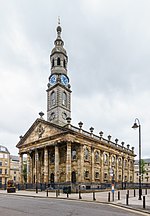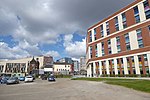Gallowgate railway station
Disused railway stations in GlasgowFormer Glasgow and South Western Railway stationsGlasgow railway station stubsRailway stations in Great Britain closed in 1902Railway stations in Great Britain opened in 1870 ... and 1 more
Use British English from September 2022

Gallowgate railway station was a station on the City Union Line in Glasgow, Scotland. It was situated a short distance east of Glasgow Cross at the junction of Gallowgate and East Nile Street, today Molendinar Street. The station opened on 18 December 1870, then closed and shortly reopened in 1871. It closed permanently on 1 October 1902. Workmen’s service operated until 1926 or 1934. The bridge which carried the tracks to the station remains standing, as the line is still used by empty stock passengers trains to and from Shields Depot south of the River Clyde and occasional freight trains.
Excerpt from the Wikipedia article Gallowgate railway station (License: CC BY-SA 3.0, Authors, Images).Gallowgate railway station
Molendinar Street, Glasgow Merchant City
Geographical coordinates (GPS) Address Nearby Places Show on map
Geographical coordinates (GPS)
| Latitude | Longitude |
|---|---|
| N 55.8564 ° | E -4.2416 ° |
Address
Molendinar Street
Molendinar Street
G1 5AS Glasgow, Merchant City
Scotland, United Kingdom
Open on Google Maps






